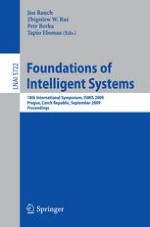This book constitutes the refereed proceedings of the 18th International Symposium on Methodologies for Intelligent Systems, ISMIS 2009, held in Prague, Czech Republic, in September 2009. The 60 revised papers presented together with 4 plenary talks were carefully reviewed and selected from over 111 submissions. The papers are organized in topical sections on knowledge discovery and data mining, applications and intelligent systems in Medicine, logical and theoretical aspects of intelligent systems, text mining, applications of intelligent sysems in music, information processing, agents, machine learning, applications of intelligent systems, complex data, general AI as well as uncertainty.
